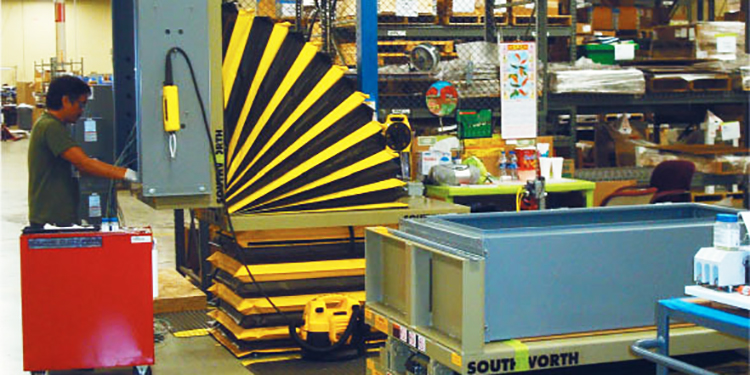Pair Ergonomic Solutions For Safer Pick-And-Place

With the bulk of workers’ compensation overexertion claims associated with manual material handling — like pulling, pushing, lifting, carrying, holding and reaching — it’s important to look for ergonomic assist equipment that reduces those strains while minimizing repetitive motions. For manual pick-and-place processes that involve repeatedly reaching for, picking up, and lifting items out of a container or off a pallet, a solution that pairs a floor-based load tilter with an overhead lifter can accommodate all shapes and sizes of both products and workers.
Underneath the load, a powered industrial tilter both lifts and tilts a load, raising the contents of a bulk container to the optimal height and angle for an associate to reach in and pick the item. The tilting function, controlled by the worker, allows the container to tip toward him or her at a range of pitch angles (attitudes). When the container is full, the worker removes the top layers; as the contents are depleted, the worker raises and tilts the load for easier access to the remaining items.
Tilters — which come in mechanical, pneumatic or hydraulic operation styles — can be either fixed or portable, and come in a variety of sizes and capacities to match the load being handled. In addition to improving ergonomics, tilters can also contribute to increased worker productivity by bringing items closer for picking. Healthcare practitioners recognize that reaching out from the body puts greater strain on the lower back than bending over. Reducing the reach is not only healthy, it also saves time, therefore improving efficiency and productivity.
Overhead, lifting equipment works in concert with load tilters and lifters. As directed by the worker, these devices, such as hoists, balancers or vacuum lifters, engage the load in some way depending on their end effector (hook, clamp, or suction). Once secured, the lifting device picks up the product and moves it to its next destination under worker control, and at waist height for proper ergonomics. Conversely, these lifters can also be used to build loads, such as stacking cartons on a pallet. Either way, the device does all the work — removing the need for workers to lift, bend, twist, or reach while eliminating the stress and strain on their backs.
Looking for more lifting options for better ergonomics in your operation? In the MHI Solutions article, “Repetitive Pick-and-Place Actions Find Solutions with EASE,” members of MHI’s Ergonomic Assist Systems & Equipment (EASE) Industry Group discuss this topic in more detail.



